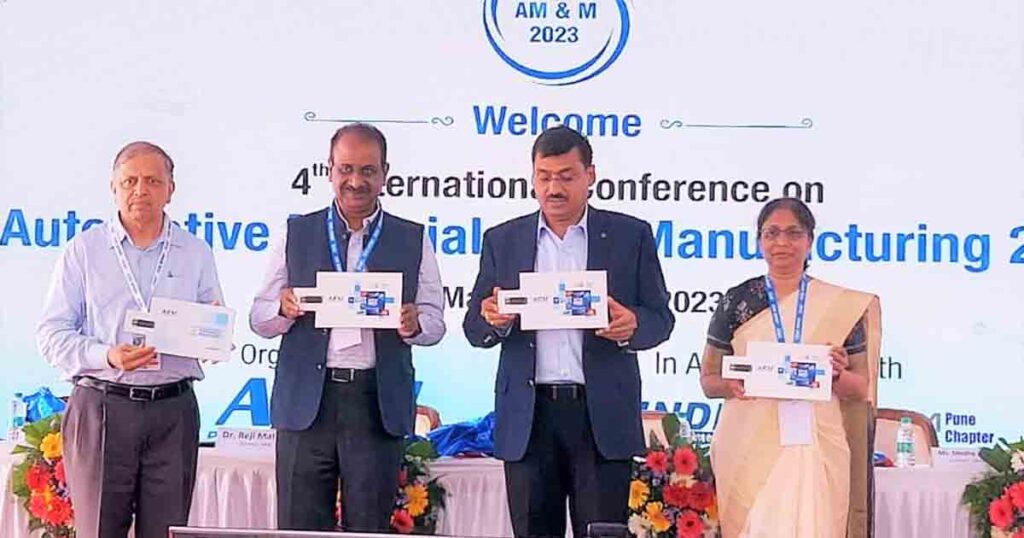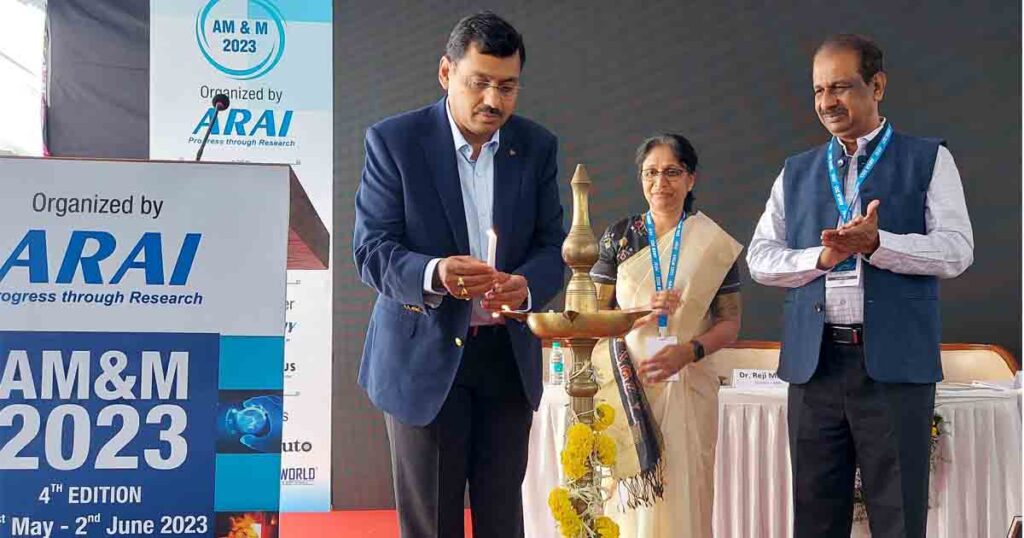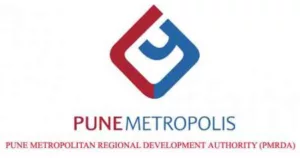3 Day Conference on Automotive Materials and Manufacturing 2023 begins at ARAI-HTC, Chakan

Pune, May 31, 2023: The fourth edition of International Conference on Automotive Materials and Manufacturing AM&M 2023 opened with an emphasis on making the Indian auto industry environment friendly through newer materials and processes.
The Automotive Research Association of India (ARAI) called the fourth edition of the conference and the exposition (AM&M EXPO 2023) open on Wednesday.
The conference is being held physically after the third edition conducted in online mode due to the COVID 19 pandemic. This conference is being hosted at Homologation and Technology Centre (HTC) of ARAI at Chakan Pune from 31st May to 2nd June 2023. It is being organized in association with SAE India and ASM International (Pune Chapter).
ARAI Director Dr Reji Mathai in presence of AMM 2023 Convener Medha Jambhale welcomed the dignitaries present for the conference, including Deepak Garg, Managing Director, Sany Heavy Industries, along with Dr. Hanif Qureshi, Joint Secretary of Ministry of Heavy Industries, Government of India, and Rajendra Petkar, CTO, Tata Motors and President of ARAI, who addressed the gathering virtually.

Dr. Hanif Qureshi emphasized the need to bring in a greener approach in the automobile manufacturing industry to face the stringent emission norms around the world.
“The automobile sector is an important part of the growth story of the emerging modern India. The sector is now more than $120 billion and is about 7% of the size of the Indian economy. It contributes more than 35% of the jobs in the manufacturing sector. We envisage new challenges as governments around the world are talking about stringent emission norms and fuel efficiency.”
He added that the industry is looking for advanced materials that would help them in reducing environmental impact. “This is the time when the Indian automobile sector is oiled for growth, but along with this growth, there are certain challenges as we have to look for advanced materials and processes which will hasten our journey towards not only better automobiles and better fuel efficiency, but also reduced environmental impact through improvement in manufacturing processes,” Dr. Qureshi said.
In his welcome note, Dr Mathai appreciated the efforts put in by materials and manufacturing teams in the automotive industry. He said: “Speaking about the automotive industry, we all know how critical and important a role it plays in the country’s growth. As if we are evolving day after day, many of us are prepared for the systematic challenges that are placed before us, but the sudden disruption jolts us and makes us think differently. They make us think ahead, so that we are prepared for any disruptions and bring a better situation to the ambient air quality, safety to the passengers, and value to the customers. Materials and manufacturing play a very vital role in that. It’s a very silent work that keeps on going behind the curtain.”
He also gave a sneak peek to the three-day conference. “There will be 44 technical papers in 14 technical sessions spread over three days. We’ll have renowned automotive experts sharing their views through 20 keynote addresses and preliminary sessions, and we will be having two panel discussions, especially focused on big data analytics in materials and manufacturing and materials for sustainable mobility. Alongside this conference, we have our expo, thanks to these exhibitors who bring in their solutions and their products so that the industry can have an interaction one-on-one.”
Rajendra Petkar said that the role of materials and manufacturing technology is going to be crucial in the growth of the industry. “The Indian materials industry has made a significant advancement as regards to development of new and alternate materials. The materials engineering and the manufacturing community continues to innovate relentlessly in order to enter the requirement of products to which keep ever evolving. The attributes such as vehicle safety, fuel efficiency, vehicle weight, emissions, durability and reliability are actually determined by the choice of the materials and the manufacturing process. For modern day automobiles, the form, aesthetics and quality play a critical role in buying decisions of a consumer as well as public user experience.”
“The auto industry is at the cusp of further technology and product transformation. The three important pillars of sustainability are basically net zero, circularity and biodiversity. While a great deal of technological understanding has emerged as far as the pathway to net zero is concerned, circularity is emerging as the next frontier where the materials and the manufacturing processes are going to play a critical role. To put this simplistically, circularity is an ultimate closed door production system in which companies reduce waste throughout the supply chain and in the manufacturing and when those products reach end of life, they are recovered and then disassembled, repurposed, renovated, recondition and recycled as appropriate,” Petkar added.
Addressing the gathering during the inauguration function, Deepak Garg highlighted the significance of the Indian automobile industry and the need for its further expansion. He said, “Indian automobile industry is a significant contributor to India’s GDP. It is currently accounting for almost 49% of the manufacturing GDP and 7% plus of total GDP. The rapidly growing automobile industry is now worth over $200 billion, contributing almost 8% of the country’s total exports and generating employment of more than 37 million people. As India targets to surpass GDP of $5 trillion by 2025, the goal set by our honorable Prime Minister coupled with the target to achieve net zero emissions by 2070, the significance and potential for the automobile sector will increase further.”
“The automobile sector will have to transform its current technological landscape to meet the environment and sustainability goals of the country. Recently, India became the most populated country crossing 140 crores. It has further become a very attractive investment destination in the automotive sector. Several initiatives by the Government of India to support the automotive sector are proving to be beneficial. In the last two decades i.e. till 2022 the industry attracted FDI of almost $34 Billion and the Government is expecting another 8-10 Billion USD in 2023 and continue the same momentum till 2030”, Garg informed.
Garg also hinted at the new opportunities which will be generated due to the government’s encouragement for electric vehicles. According to him, the Government has set the target to reach 30% of vehicles by 2030 on electric. Electric vehicle industry is set to grow at a CAGR of about 49% from 2021 – 2030 which might just translate into 17 million units by 2030 with an employment potential for 50 million by 2030. He opined that the Indian automotive industry is growing with the help of good initiatives of the Government like PLI scheme , Automotive Mission plan 2026 under initiatives like Make In India, and Atmanirbhar Bharat. Apart from the steady growth in various other sectors, India could be a leader in the shared mobility sector due to rapid increase in population.
A project on Material Model Data Database to create a comprehensive repository of material model cards for damage simulation was launched during the inauguration. The event concluded with the vote of thanks by Medha Jambhale.











